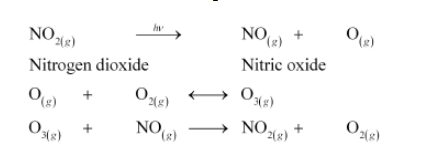Write down the reactions involved during the formation of photochemical smog.
Photochemical smog is formed as a result of the reaction of sunlight with hydrocarbons and nitrogen oxides. Ozone, nitric oxide, acrolein, formaldehyde, and peroxyacetyl nitrate (PAN) are common components of photochemical smog. The formation of photochemical smog can be summarized as follows:
Burning of fossil fuels leads to the emission of hydrocarbons and nitrogen dioxide in the atmosphere. High concentrations of these pollutants in air results in their interaction with sunlight as follows:

While ozone is toxic in nature, both NO2 and O3 are oxidizing agents. They react with the unburnt hydrocarbons in air to produce formaldehyde, PAN, and acrolein.

Click here to get exam-ready with eSaral
For making your preparation journey smoother of JEE, NEET and Class 8 to 10, grab our app now.
